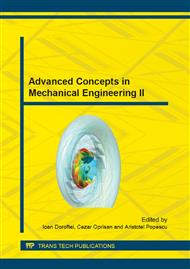p.481
p.487
p.493
p.499
p.503
p.511
p.515
p.521
p.527
Experimental Determination of the Heat Recovery Boiler Effectiveness of a Gas Turbine Plant
Abstract:
Increasing the energy efficiency of a gas turbine plant can be achieved by exhaust gas heat recovery in a recovery boiler. Establishing some correlations between the parameters of the boiler and of the turbine is done usually based on mathematical models. In this paper it is determined from experimental point of view, the effectiveness of a heat recovery boiler, which operates together with a gas turbine power plant. Starting from the scheme for framing the measurement devices, we have developed a measurement procedure of the experimental data. For experimental data processing is applied the effectiveness - number of transfer unit method. Based on these experimental data we establish correlations between the recovery boiler effectiveness and the gas turbine plant characteristics. The method can be adapted depending on the type of flow in the recovery boiler.
Info:
Periodical:
Pages:
503-508
Citation:
Online since:
October 2014
Authors:
Keywords:
Price:
Сopyright:
© 2014 Trans Tech Publications Ltd. All Rights Reserved
Share:
Citation:


